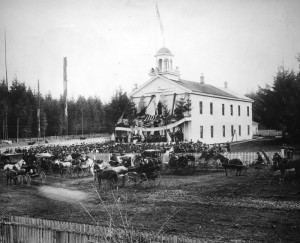About
Washington State is divided into 49 legislative districts – each served by one Senator and two members of the House of Representatives. In both the House and Senate, there is a Republican Caucus and a Democrat Caucus. A caucus is a decision-making body whose members share a common political philosophy, guiding principles and values. The Senate Republican Caucus, therefore, consists of Republican members of the Washington State Senate who meet together and work as a team.
Senate Republicans believe that government should be held accountable to the taxpayers, that budgets adopted by the Legislature should be fiscally responsible and sustainable during economic downturns, and that the best government is one which governs by encouraging individual initiative and responsibility.
History
 On February 22, 1889, outgoing United States president, Grover Cleveland, signed enabling legislation providing for statehood for the Dakotas, Montana and Washington. It set the first Tuesday after the first Monday in May as the date for election of delegates to the constitutional convention. The 75 delegates elected included 43 Republicans and 29 Democrats. Their average age was 45 years and they represented a broad cross-section of the leadership of the Territory. The convention opened at Olympia on July 4, 1889, and concluded with a final document approved on August 22.
On February 22, 1889, outgoing United States president, Grover Cleveland, signed enabling legislation providing for statehood for the Dakotas, Montana and Washington. It set the first Tuesday after the first Monday in May as the date for election of delegates to the constitutional convention. The 75 delegates elected included 43 Republicans and 29 Democrats. Their average age was 45 years and they represented a broad cross-section of the leadership of the Territory. The convention opened at Olympia on July 4, 1889, and concluded with a final document approved on August 22.
The proposed constitution was submitted to the voters along with three ballot measures on issues upon which the delegates could not agree: prohibition, women’s suffrage and the location of the seat of government. At the October election, the constitution was adopted handily but prohibition and women’s suffrage were overwhelmingly defeated. A substantial plurality of voters favored Olympia as the capital, but not a majority. This required a second vote on the location among the top three finishers. At that election in 1890, Olympia won out over Ellensburg and North Yakima.
The newly elected Legislature assembled in Olympia in the first days of November, eagerly awaiting news that admission to the Union had finally been accomplished. Shortly after 5:00 p.m. on the afternoon of November 11, 1889, new U.S. President Benjamin Harrison signed the bill which proclaimed Washington the 42nd state to be admitted to the Union. The news was immediately transmitted to Olympia by wire. The newly elected Legislature was gathered awaiting the word and upon its receipt great jubilation ensued. The long campaign for statehood had finally ended.
Washington had been moderately Republican since the Civil War and the first state election reflected this. All state-elected officials in 1889 were Republicans. In the Legislature there were: 34 Republicans and one Democrat in the Senate and 62 Republicans and eight Democrats in the House.








